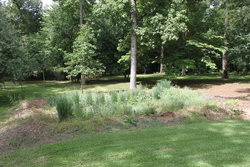 Several new rain gardens at SFA's Pineywoods Native Plant Center will improve the quality of water entering Lanana Creek during heavy rainfall. The gardens are designed to catch water coming from the parking lots of Raguet Elementary, the Tucker House and the Music Preparatory Building to reduce pollutants and prevent erosion.
Several new rain gardens at SFA's Pineywoods Native Plant Center will improve the quality of water entering Lanana Creek during heavy rainfall. The gardens are designed to catch water coming from the parking lots of Raguet Elementary, the Tucker House and the Music Preparatory Building to reduce pollutants and prevent erosion.NACOGDOCHES, Texas - Through a partnership between the Arthur Temple College of Forestry and Agriculture and SFA Gardens, three rain gardens now enhance the quality of water entering Lanana Creek during rainfall events.
Rain gardens are being implemented across the country to help reduce pollutants and prevent erosion as rainwater washes off impervious surfaces such as parking lots and into the vegetated depressions, according to Dr. David Creech, director of SFA Gardens. SFA's new rain gardens are located within the Pineywoods Native Plant Center and are situated to catch water coming from the parking lots of Raguet Elementary, the Tucker House and the Music Preparatory Building.
"Water comes off of these parking lots and is full of all the noxious pollutants that we don't want to see end up in the streams, creeks and rivers of East Texas," Creech said.
The project came about after a trip to Washington, D.C., during which Dr. Matthew McBroom, assistant professor of forest hydrology, saw a rain garden located near the National Arboretum. The rain garden, he explained, located in the heart of the city's dense urban development, works to improve the quality of rainwater runoff before it enters the Chesapeake Bay Watershed. McBroom said he immediately thought this would be a beneficial addition to the SFA campus.
"In keeping with SFA's sustainability mission and also in thinking about how we train students, we decided that rain gardens are a very effective way to manage non-point source pollution from urban areas," McBroom explained.
To understand the effects of the rain gardens, environmental science graduate student Zhengyi "Justin" Wang studied the water quality before and after its transition through the gardens, explored the differences among the rain gardens and modeled their basic hydrologic function.
McBroom said those involved are encouraged by the results of this first-year study and expect the efficacy of the gardens to increase as the plants grow and establish larger root systems. In the coming years, other graduate students will continue to track the gardens' effectiveness and make improvements in their design.
While the gardens' primary purpose is improving water quality, they provide a number of other advantages, including vegetative diversity, wildlife habitat and aesthetic appeal, the faculty members said. Also, if constructed with native plants, as the SFA rain gardens are, they require relatively little upkeep.
For information on related topics, visit the college of forestry and agriculture's website at www.atcofa.sfasu.edu.
 Axe ’Em, Jacks!
Axe ’Em, Jacks!